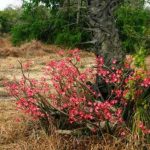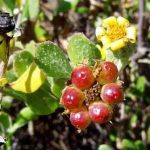TREE LIFE
October 2005
MASHONALAND CALENDAR
Sunday 2nd October: Something different this month. “Show and Tell Members’ Evening”.
This will be a social evening at Adele Hamilton Ritchie’s house, 3 Normandy Road, Alex Park.
The idea is to bring along a few slides or computer images of botanic interest, or a specimen of any interesting or puzzling plants, or even a book. We will discuss your contributions or you may like to speak about them yourself. Adele has a slide projector and Mark a LCD projector.
This should be a fun get together, and not too demanding on our precious fuel.
Please bring something to eat and drink to share. Time – 6 for 6.30,
Tuesday 4th October: Back to Tuesday evenings with the arrival of summer.
Botanic Garden Walk. Subject ‘This and That’. If Tom is still away Mark will be standing in for him. Meet in the car park at 4.45 for 5 pm.
Sunday 9th October: NB. As Mark will be away for most of this month the outing has been brought forward a week.
We will visit Dombashawa again, but this time we will take the cooler walk near a little stream on the lower slopes. This is a lovely fairly well treed and easy walk. Because of the fuel crisis, please phone Mark or Maureen to confirm that this trip is still on and to arrange lifts – we will meet at 9.30 am. Bring your lunch, water etc.
Saturday 22nd October: Mark will be away so his walk this month is cancelled.
MATABELELAND CALENDAR
Please contact Jean Wiley or Gill Short for details of the next Matabeleland function.
Some time ago when the Tree Society spent a marvellous week end in the Honde Valley we were shown some of the magic of Aberfoyle Tea Estate by Nick and Soo Fawcett. On one outing we happened to stop alongside a large patch of thorny red berries, where ‘a feeding frenzy’ ensued. The plant’s name however has eluded us till recently when Mick Fleet was able to get her specimen identified by the Royal Horticultural Society and this is what was reported.
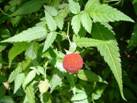
Rubus rosifolius. Photo: Wikipedia
“the specimen appears to be of Rubus rosifolius, a native of eastern Asia, although it is commonly known as Mauritian raspberry. It has rose-like leaves and small recurved thorns along the stems and leaves. The white flowers are followed by large red fruits similar to a raspberry but with many more segments. The fruits are edible but considered to be somewhat insipid or dry. The plant can become invasive in warmer parts of the world”.
BOTANIC WALK: 2 JULY 2005
Nothing specific had been planned for this walk but fortunately Meg Coates Palgrave was there and stepped in to guide us on our walk.
The question for today was: do trees which are early deciduous (e.g. species of Commiphora which spend a lot of the year in a leafless state) possess a green underbark which enables them to photosynthesize even without leaves? This might seem to give these trees an advantage.
Examples of trees which fit both these conditions are Commiphora spp – a classic example would be C. marlothii, Kirkia acuminata and Adansonia digitata (the baobab).
As we walked around the gardens, we tested this hypothesis in a rather random way and the results were somewhat disappointing. It appeared that many trees have a greenish underbark and these include many species which keep their leaves most of the time.
We looked at the Sausage tree, Kigelia africana. Meg explained that this drops its leaves at the first sign of frost. This specimen in the Garden still had a reasonably full compliment of leaves, thereby suggesting that the winter had been relatively frost free. At this stage (early July) no flowers had yet appeared – but surely they could not be too far off? There were still many ‘strings’ showing where fruit had been.
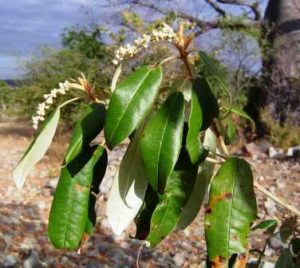
Croton gratissimus. Photo: Bart Wursten. Source: Flora of Zimbabwe
Croton gratissimus is known as the Lavender croton. Leaves and inflorescences were crushed and smelled by those present but the general consensus was that it did not particularly smell of lavender. The silvery scales are used as an eye shadow and in the days of Lobengula, only the wives and princesses were allowed to use it. Another feature of this species is the occasional yellow leaf on the tree.
Meg described the unusual flowering life cycle: buds appear in c. February (i.e. during the rainy season) and sit unopened and externally inactive throughout the winter. The spikes bear male flowers near the apex and are female below. The actually flowering takes place in September/ October just before the rains return.
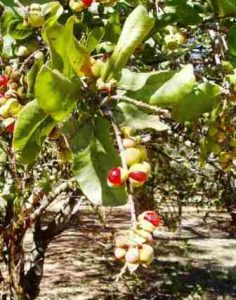
Pappea capensis. Photo: Mark Hyde. Source: Flora of Zimbabwe
Pappea capensis (the Indaba tree). Again, this has an unusual flowering mechanism, which Meg described as follows. The male flowers appear first and then only if conditions are right do female flowers appear later.
The specific Indaba tree grew within Lobengula’s kraal and, as the name suggest, meetings were held beneath it. He reigned from c. 1869 to the 1890s. The tree died about 100 years later, but it is believed to be suckering from the base again and so is obviously not entirely dead.
Another species we looked at was Ficus natalensis subsp. graniticola. This is a woody, milky species with dark green, often truncate leaves and prominent stipules which occurs in rocky hills in Zimbabwe.
Meg mentioned an interesting spot character, namely that the midrib does not flow though from the petiole, but appears as if it had been stuck on.
We are most grateful to Meg for leading us so effectively and at such short notice.
-Mark Hyde
On a recent Walk in the Botanic Gardens we looked at some bamboo which was flowering.
In a follow-up letter June Searson wrote….
“The Bindura Bamboo (Oxytenanthera abyssinica) – there are 2 large clumps of them on my property and I have been watching them closely because it is time they flowered again, so it was of great interest that the specimens in the Botanic Gardens are flowering now. Ours last flowered in 1967 and yes, they did die and grew up again from the copious seeds on the ground. ‘Notes on Indigenous Trees and Shrubs of S. Rhodesia by A A Pardy has a lot of information on the bamboo. I quote from my notes that I made at the time of flowering.
“Oxytenanthera abyssinica. Flowered Jan/Feb 1967. Stems swept low towards the ground by the weight of prolific seed. Pied mannikins (Spermestes fringilloides) made first recorded appearance here; eat seeds of bamboo eagerly, perhaps exclusively. Vociferous, gay, given to high flying and much communal bathing. About 30 of them here for about 2 years while the seeds lasted.” They have a loud, cheerful call – pee–op-pee-op and we missed them when they left. Did they return to Bindura? How do they find flowering bamboos which are so widely scattered? There was correspondence in the ornithological magazine at the time because other people had noticed the birds and the bamboos in flower on their property. Have the mannikins arrived in the Botanical gardens? Neither Roberts 1940 and 1978 nor Pardy mention the association but Roberts 1985 mentions the birds.
And also from June’s letter…
‘The next item which interested me was the orchid outing to World’s View. Mr. B. Wursten no doubt knows about the collection of orchid paintings by Mr. L. Vereker. He and his friend Mr. Greaterex explored Rhodesia for many years collecting and identifying and painting orchids in the 1920s, 30s, and 40s. Mr Vereker painted and Mrs. Greaterex wrote the notes. This collection of really superb paintings is housed at the Herbarium and can be viewed by members of the public by appointment. So many are there, carefully preserved in folios, that it takes about 2 hours to look at them. {TreeLife 305; August 2005}
HASLEMERE LANE, UMWINDSIDALE: 21 AUGUST 2005
This outing was to have been at the lovely home of Norman and Eleanor Dickens in the Umwindsidale area of Harare. However, on their return a few days before, they found that a huge fire had severely damaged the trees in the area. After Maureen had reported this to me, we decided to try and move it a short distance away to Mick Fleet’s house in Haslemere Lane. Luckily and at very short notice, Mick agreed to host us.
So, on a beautifully warm Sunday morning we all gathered in the car park near to Mick’s cottage. The turn-out was surprisingly good – about 20 people. Numbers at our outing seem to have improved generally as members have managed to make ‘arrangements’ to overcome the fuel shortages. For the record, the altitude was 1410 m, very slightly lower than central Harare (which is about 1480 m), but that sort of difference was not enough to make a noticeable difference in the plants seen.
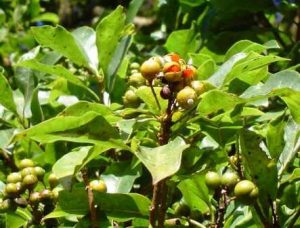
Pittosporum viridiflorum. Photo: Bart Wursten. Source: Flora of Zimbabwe
We started off following a path that curves around a low tree-covered rocky hill. Here were numerous specimens of an evergreen species, the Cheesewood, Pittosporum viridiflorum. This may be quite a large tree, but very often, as here it is a slender sapling, growing in the under storey of woodland. We noticed the spirally-arranged simple leaves and the lenticellate bark. It does have weedy tendencies and will colonised disturbed woodland. It is very common in the Harare area.
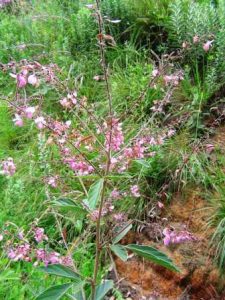
Pseudarthria hookeri. Photo: Bart Wursten. Source: Flora of Zimbabwe
In the woodland was Pseudarthria hookeri, one of a number of species known as Bug catcher. At flowering time, it is a very striking pink-purple legume, but at this time of the year, (end of winter) there was little to see but the leaves and the dried-up pods. This species is also known as the Velcro plant as the 3-foliolate leaves will readily adhere to one’s clothing and can be worn as a sort of botanical badge.
One sign that winter was on the way out was the flowering msasas. We smelt their delicate scent and admired their by now generally green new foliage.
An interesting sight was occasional small specimens of a species of Macadamia which had self-sown themselves in the woodland. This is not a common exotic in Zimbabwe; I’ve only seen it before in the Vumba where it had escaped in forest edges. Here it was rather different – a constituent of quite open miombo woodland. Also seen were some leaves of an epiphytic orchid, Aerangis verdickii. Again, it was the wrong time of year to see its spectacular white flowers with their long white spurs.
In the woodland was a large specimen of Diplorhynchus condylocarpon, the Rubber tree. This specimen showed off the splendid dark crocodile-type bark. Leaves are opposite and bear milky latex. Fruits are thick brown follicles, usually occurring in pairs, unless one aborts for some reason. A surprising component of the herbaceous layer was Abrus precatorius. Here it was in fruit displaying the cluster of pods from which hang seeds which are bicoloured red and black. It is quite a striking species and typically occurs at rather lower altitudes than this. However, we have seen it at Bill Clarke’s plot near Ruwa, which is at an even higher altitude, so obviously it does occur albeit sporadically.
A little further on we came across a beautiful flowering species, namely Turraea nilotica. This is often a very early species in miombo woodland and we soon found many small trees and shrubs bearing the yellowish-green flowers. Like many Meliaceae the flower has a very prominent staminal tube, which was very easily spotted on these plants. The plants were mostly leafless at this stage.
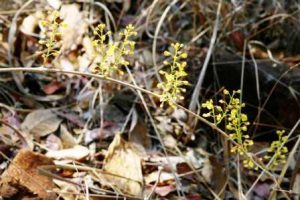
Plectranthus esculentus. Photo: Bart Wursten. Source: Flora of Zimbabwe
A low-growing and sprawling Ximenia caffra was seen, covered in buds – but not a single one was open at this stage. Then in some rocky woodland we came across numerous sprawling stems of a striking yellow-flowered species, namely Plectranthus esculentus. This also flowers when leafless; later in the year leaves appear on the same whippy stems, simple and opposite. The plant is said to have a large underground storage organ – but I have never dug one up to have a look.
As we approached the water tank on the second hill, more flowering trees appeared. Erythrina abyssinica (Lucky bean tree or coral tree) is a common species with us; it is often winter-flowering and bears striking red flowers and pods which are deeply constricted between the seeds. Also present was Tetradenia riparia (the Ginger bush), covered in small purplish flowers.
After descending from the hill, we wandered into more open woodland which was an extension of the garden and contained an interesting mixture of native and planted trees. Bauhinia variegata was there looking very attractive with its white to purplish-pink flowers. We examined the calyx of this species – it is like a spathe, an asymmetrical object enclosing the flower at the base which is not divided into a number of lobes as calyces usually are.
Also present was Vernonia myriantha. This is a tall shrubby species which bears large panicles of purple flowers. It also, unusually in Asteraceae, bears large ear-like false stipules on the stem at the base of each leaf stalk. (The older name was the more apt Vernonia stipulacea). Unfortunately, these very recognisable stipules tend to fall off, and by flowering time they tend to be absent. As we have mentioned before, this species might just be confused with the Bug Tree, Solanum mauritianum, which was present and which also sports large false stipules. In flower and fruit they are completely different species however and in leaf can be separated by the stellate hairs on the Solanum.
After our walk, we all had lunch outside in the car park.
We are very grateful to Mick for hosting the Society at very short notice. This is always an interesting place and we hope to return there again in the future.
-Mark Hyde
THE PETHERAM FILES Continued…..
This, sadly, is the last of the amazing Petheram Files, a fitting memory to Dick Petheram, and to Lyn Mullin who collated them for our enjoyment.
This and That
Oil That Grows on Trees
This extract from a longer article in The Straits Times of Tuesday, 7 July 1981, is reproduced with minor editing. It reads almost like a story specially produced for April Fool’s day.
A petroleum tree discovered in the Philippines has triggered of a search by other Southeast Asian countries in their own backyards to see if an oil bonanza is growing there, ready to be tapped.
Since the tree—known in Filipino as hanga—was brought to the attention of the government in January, the Bureau of Plant Industry in Manila has been deluged with requests from the Philippines’ neighbours for samples of the fruits.
When cut, the hanga fruits, which grow in clusters, yield a kerosene-like oil. For an oil-starved country like the Philippines—which imports 85 percent of its energy needs in the form of crude—the petroleum tree seems like a dream.
And the government is furiously making efforts to turn dream into reality. A plan has been drawn up to propagate the hanga to make it commercial in three years’ time. Its impact on overall energy production is still not measurable. But it definitely will have great significance, considering it grows in wild profusion all over the country. Petroleum tree cultivation thus falls under the government’s long-range programme to exploit non-conventional alternative sources of energy.
The petroleum tree is likely to be a frontrunner in the production of fuel from agricultural products, being less complicated and less expensive than alcogas and cocodiesel, which are also receiving a great deal of government attention.
But like the latter two—which had been used in the Philippines during times of hardship like World War Two—the hanga was brushed aside by the Bureau of Plant Industry when school-teacher Juan Liwag brought the seeds to its attention in 1974. Imported petroleum was still cheap, but it was the persistence of Liwag and the recent alarming increase of oil prices that caused the bureau to site up this year.
Hanga grows wild in the tribal province of Kalinga-Apayao, about 400 km north of Manila. It has been used for centuries as a source of light, as well as for stomach ailments and insect bites.
When chemically tested, the fruit (no longer than 5 cm) was found to contain 16 percent pure alcohol, which burns easily when a match is put to it. Blue flame gives way to black smoke, caused by a thick coat of resin surrounding the seeds.
The excitement it ignited led to a nation-wide search for the tree. It was discovered that hanga thrives best in elevated areas of 329-658 m, with temperatures of 21-27°C. The tree was found to thrive in many parts of the Philippines—in Laguana, south of Manila. In the cool mountains of Benguet, Isabela (northern Luzon Island), Albay (southeast Luzon), North Cotabato in Mindanao Island, and Samar Island in the Visayas.
It starts fruiting after three years, and flowers three times a year. Each tree yields 15 kg of hanga fruits per harvest. “The commercial impact is immeasurable”, says Rene Mondragon, Chief of the Crop Division of the Bureau of Plant Industry, which is conducting rapid propagation of the plant in various experimental stations. “We are still experimenting, and it is too early to say how much it could contribute to total energy consumption. But we believe the hanga tree will definitely be a great help to the Philippines’ energy needs”, he adds.
The oil needs no processing for use in lighting household lamps, and for cooking.
Between February and May almost 8 000 cuttings and thousands of seeds were planted. The seedlings will be sold commercially. Since the tree loves shade, Mr Mondragon thinks that hanga can be planted between rows of coconut trees.
[Comment 2002: Nowhere in the article was there any mention of a botanical name for hanga, and it might be interesting for someone with access to Internet to try to get this, as well as up-to-date-information on how far the project has progressed. Some forest trees from the Philippines grow very well in certain parts of Zimbabwe, eg Pinus kesiya—and even P. merkusii and Eucalyptus deglupta can perform reasonably well.]
Just for Interest (Source: The Guardian)
Question Where does the expression “touch wood” originate?
Answers
– Touching wood is supposed to summon up a dryad, or earth elemental, in order to bring about good luck. This tradition probably originated in early Celtic cultures. The wood one would want to touch was originally hawthorne – but has evolved to encompass all wooden surfaces – I’ve even seen people do it with formica!
– In Britain and many parts of Northern Europe certain trees (in particular the oak, hawthorn and willow) were considered sacred and had certain powers and people touched them if they wanted to avoid bad luck.
–In earlier, more primitive times, great significance was attached to relics of saints, and of the cross on which Jesus was crucified, and to this end, there were any number of reliquaries which contained a tiny splinter of wood, purporting to be a piece of the cross. These were displayed in chapels, and the faithful masses would queue up to touch the reliquary, and say a prayer for their souls, or the death of their enemies or whatever. Wealthier people would have a splinter of their own, that they would carry in a locket, or inside a crucifix. When they were wishing good luck upon an endeavour, they would ‘touch the wood’, and ‘touch wood’ became equivalent to ‘If God wills it.’
– It may be a short form of knock on wood, which comes from the belief that if evil spirits heard you talking about something good they would ruin it for you; thus you had to knock on wood (make noise) so they couldn’t hear word of your good news
– I understand Dara’s explanation to be a Christianising of a far older ritual. Trees were held to be sacred and tree spirits were worshipped in pre-Christian times. Touching wood (or “knocking on wood” as Americans call it) either summoned or put one in contact with the tree spirit. The tying of cloth strips to trees at the site of old holy wells and springs is part of this same belief and is still current.
– Philip’s quite right when he says the practise of touching wood is a hangover from pre-Christian days, much like Christmas, Halloween etc. However, the expression ‘touch wood’ can only be traced to the 17th Century, and is specifically directed to relics of the cross. Incidentally, it’s been calculated that there are enough relics of the true cross in existence to build the Ark. (there seems to be something missing here – nothing on the hard copy???)
MARK HYDE CHAIRMAN


